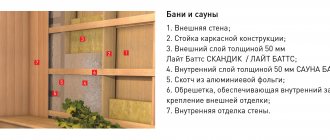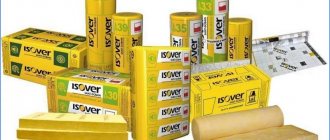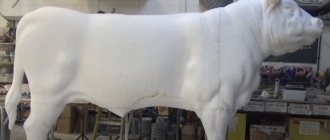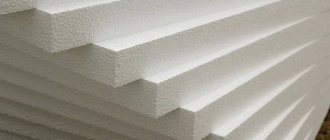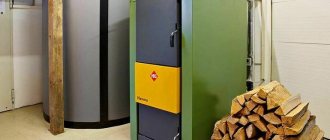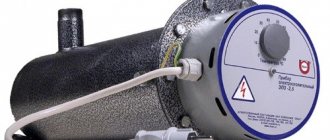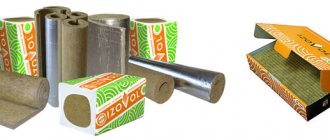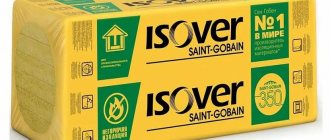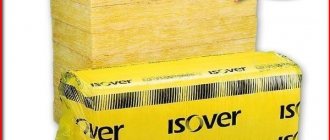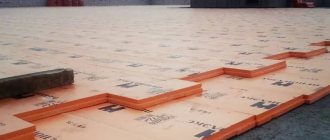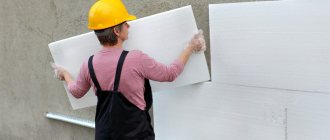One of the most pressing problems of any insulation and any insulation is cold bridges. These are metal frame jumpers and joints between sheets of insulation, where precious heat leaks. Logically, this problem can be solved by coming up with a material that will immediately stick to the surface without requiring a special frame. It is this type of insulation that has begun to gain popularity in a variety of construction sectors. How true are all the manufacturer’s assurances about the versatility of this material? Let’s figure it out together.
Features of sprayed thermal insulation
As a result of mixing two substances, one of which has insulation properties, an enhanced foaming process begins. This foam adheres perfectly to any surface and does not require any frame. It seems that a panacea in the world of insulation has been found, but insulation has a number of disadvantages, which we will talk about a little later.
The main advantage of sprayed insulation is the ability to insulate any surface, which significantly speeds up the work. One person can insulate a private house of 5-6 rooms in 2-3 hours. Therefore, such insulation is beneficial in terms of speed of work and absolute indifference to the rough surface
Features and beneficial properties of polyurethane
When choosing attic insulation using polyurethane foam, you need to know what properties the declared material has. All detailed data will be presented in the table.
| Characteristic | Indicators |
| Thermal conductivity | 0.03 W (m*K) |
| Weight of the insulating layer | 30-70 kg/cub.m |
| Waterproof | Full (for closed cell material) |
| Fire safety | Level G-2 |
| Adhesion | High (for any surfaces) |
| Adjusting layer thickness | Possible during operation |
| Additional functions | Noise insulation |
| Drying time | 1 hour |
| Treatment against rodents and insects | Not required |
| Lifetime | 40-50 years |
Advantages and disadvantages
Let's look at all the pros and cons. We will try to comment on each quality provided by the manufacturer in order to accurately indicate the real properties and non-existent “advantages”.
Advantages of insulation:
- Sticks to any surface. For insulating log houses and complex turns of heating pipes, this material is truly irreplaceable. However, it is worth clarifying that you will still have to prepare the surface before application: remove excess dirt, dust and moisten the surface.
- No cold bridges. To some extent this is true, because insulation does not require a frame. But on the other hand, the surface with applied insulation does not look very beautiful, if not disgusting. In addition, most of the sprayed insulation is afraid of sunlight. Therefore, the insulation must be covered with panel material: plasterboard, plywood, chipboard, etc. But to attach the shield, a frame is required. Thus, we return again to the problem of cold bridges. The frame can be partially covered with sprayed insulation, but this will not solve the problem forever. That is, it is possible to talk about reducing heat loss through cold bridges, but not about completely solving the issue.
- Environmental friendliness. Most modern insulation materials are environmentally friendly. Using other options is simply prohibited. However, it is worth considering that in the event of a fire, sprayed insulation begins to release a huge amount of harmful substances into the room.
- Noise insulation. This dignity cannot be criticized. The material insulates noise really well. If you have a high-quality door and double-glazed windows, you can forget about street noise forever.
- Lightweight insulation. The weight of the foam material is small, which allows it to be used for insulating light structures and attic floors.
- Moisture resistance. On the one hand, this property manifests itself in a decrease in the corrosion activity of the metal. However, this reduces the vapor permeability of the wall, which can lead to the appearance of fungus in the room. However, some types of spray insulation are vapor permeable, and it is recommended to purchase just such options.
Sprayed thermal insulation is highly environmentally friendly
. Let's look at the disadvantages:
- The first and main drawback: the price. The ever-increasing technological advancement of insulation makes this process too expensive. Although any insulation should be quite cheap.
- Requires special installation. They have not yet invented a cylinder in which both substances are mixed at once. Therefore, before using the device, you will have to prepare the suspensions and fill them.
- The entire process of preparation and insulation will have to be carried out in special suits and respirators. The insulation must not come into contact with the skin or lungs of the builder.
- Pressure. Although the material penetrates into any cracks, holes that are too large will have to be repaired. During the application process, foam particles continue to grow. Because of this, a situation may arise where foam growth continues in the crack, which widens it. You need to estimate in advance how critical it is to have large cracks.
Can I apply it myself?
This is possible, but we still recommend entrusting the work to the professionals of our company. The fact is that to create polyurethane foam thermal insulation it is necessary to carefully calculate the amount of material and choose the optimal method of application.
It is also important that polyurethane foam should be sprayed in compliance with safety measures:
- It is necessary to ensure protection of exposed skin and mucous membranes.
- Special masks with a forced supply of clean air should be used. This helps protect the respiratory system.
When applying thermal insulation materials, our employees use professional equipment. Equipment of this level is expensive, so buying it for one-time work is unprofitable. Contacting specialists will allow you to save not only time, but also money.
Types of insulation for spraying
There are only 4 options for sprayed insulation depending on the material:
- Polyurethane foam. This is one of the chemical varieties of polystyrene foam. The material is known for its moisture resistance. They produce two subtypes of material: rigid and elastic. Rigid design conducts moisture better, but puts a lot of pressure on windows and doors. In this case, elastic insulation fits better on the wall, but difficulties arise with vapor-permeable insulation. With regard to the humidity conditions of the room, the ideal option would be a hard one. The material is not so reliable in terms of thermal protection, but fungus and mold will not penetrate the house.
- Penoizol is another type of foam. The only significant difference from other materials: it needs to be poured. At the same time, this subtype of sprayed insulation does not have any other significant differences.
- Liquid ceramic insulation. This foam contains a suspension of silicone and ceramic particles. This makes the insulation layer both vapor-permeable and moisture-resistant. At the same time, the protection against sun rays of this option is much higher than that of others. However, there is also a drawback: the price is high, even for sprayed insulation. The manufacturer promises a service life of 25 years, you can trust this. But this insulation has not yet passed the test of long service life - it is less than 3 years old. It is possible that during operation some other shortcomings will emerge.
- The last type is ecowool. This is the first spray-on insulation in terms of the time the material went on sale. But this option is the least preferable of all those listed. Ecowool is crushed cellulose, which means that the insulation does not cope well with open fire and elevated temperatures. Therefore, choose a different type of spraying.
Penoizol is a type of sprayed thermal insulation
Types of polyurethane and their features of application to coatings
Before you understand the types of insulating materials, you need to understand what polyurethane foam is. This is a composition formed from two components: diisicyanate plus polyol. They are mixed in strictly equal proportions. If there is an excess in the amount of one or another of the two compositions, the technical characteristics that should manifest themselves during the operation of the insulation will suffer.
Application of polyurethane foam on plywood Source odstroy.ru
The components are mixed by placing them in a special high-pressure chamber. Both substances individually are considered toxic, but when they are combined, a completely harmless mixture appears. That is why the material can be used in residential conditions without unnecessary worry. During this process, carbon dioxide is formed, which is actually responsible for the ability to retain heat.
There are several types of polyurethane foam composition:
- Open cell. This is a lightweight type of material, and in appearance it can be confused with mineral wool. The raw material is hygroscopic, but costs more than mineral wool. If you use this type of raw material, you will additionally have to take care of the steam and waterproofing of the layer on all sides. The open-cell version is successfully used for insulating internal partitions and ceilings. For outdoor conditions, it is better to refuse to use this type of polyurethane foam.
- Closed cell. An ideal option for insulating a house from the outside; it is applied to any surface except polyethylene and is not hygroscopic. Additionally, it is divided into several varieties: medium density (28-32 kg/m3), medium density to eliminate cavities, high density (40-80 kg/m3).
Open-cell polyurethane foam for insulation Source stroiliderinfo.ru
Application area
The scope of application of the sprayed material is quite wide:
- First of all, this is industrial construction. Insulation of industrial buildings is a rather long and labor-intensive process. The use of such insulation makes it possible to significantly reduce the construction period, and therefore its cost.
- Insulation of heating mains. All large main pipelines are buried in the ground. This means that the insulation does not have any problems with ultraviolet rays. And the use of material for installing pipes during repairs significantly reduces the period of localization and elimination of an accident on the heating main.
- Low-rise construction.
Due to its price, insulation is most widely used in low-rise construction. Only owners of private houses can afford to purchase and use this type of insulation. The main reason for the popularity of this method is the acceleration of work on insulating the perimeter of the building and the ability to use one material for any surface.
Quality test of produced thermal insulation spraying
Among professional craftsmen, it is always customary to test the quality of the applied polyurethane foam insulation. Every 40 square meters, a special knife is used to cut the coating and check its thickness relative to the expected one. Next, the density of the substance is checked in the laboratory. In addition, when spraying the substance in a thin layer, its layer-by-layer application can provide the most effective result. It is taken into account that such a procedure allows for an increase in density due to free foaming. It is worth noting that the higher the qualification of the specialist, the more evenly he sprays the foam, which allows for better insulation and avoids unnecessary consumption of the substance. Standard indicators for determining a quality layer are from 3 to 5 millimeters for every 50 square centimeters.
Stages and technology of the spraying process
Let's look at the process of applying insulation to the surface of the room step by step.
Equipment
The first stage is preparing the equipment. A gun and tank for mixing foaming and hardening agents can be purchased for rent. There is no point in buying such expensive equipment just for one or two uses. It’s easier to order processing from a specialist or rent a device.
In order to begin work, it is necessary to mix the contents of two consumable tanks in the tank of the spraying installation. At the time of mixing, the worker must be wearing a protective suit and the surface must be prepared.
Surface preparation
Surface preparation is carried out in three stages:
- Cleaning the surface from dirt
- Sealing cracks with cement mortar. We must not forget about the pressure created by foam in voids. Therefore, the holes will have to be sealed in order to preserve the integrity of the building structures.
- Moisten the insulated surface. Without moisture, the foam will stick to the wall less easily.
After all the preparatory work has been done, you can prepare the mixture and begin insulation.
Basic properties of the material
Sprayed insulation Polinor. Its characteristics demonstrate excellent technical properties that exceed the properties of other materials:
ParameterValue
| Density | 18-28 kg/m3 |
| Water absorption by volume | 0.02 |
| Coefficient of thermal conductivity | 0.023-0.025 W/mK |
| Temperature | From -25 to +120 °C |
| Coating thickness | 25-60 mm |
| Probable service life | 35 years |
| Polymerization rate at t=20 °C | 40 min |
| Complete drying time | Up to 3 days |
| Failure due to compression, shear. | Missing up to 50% |
| Flammability group | G3 |
Application of insulation
A frame for future panel structures is mounted on the surface. The insulation is applied in several layers. Particular care is taken to apply the material to joints and corners. The next layer is applied after the previous one has hardened. Ideally, the house simply goes around the perimeter. If the walls of the house have a large area, then spraying is carried out in horizontal layers on one wall. First one layer, then a second layer above it. If required, the third and fourth layers are applied, after which the installer returns to the first.
Application of insulation
Technology for insulating the façade of a house with polyurethane foam
The facade of the house is insulated using standard instructions, which are described step by step below:
- We assemble the equipment, then open the valves and wait for the mixture to flow through the hoses to the sprayer.
- We pull the trigger and point the gun at the wall that needs to be insulated. We distribute the composition evenly over the entire area of the partition.
- We apply polyurethane foam strictly starting from the bottom; if there is a sheathing, then first we fill the voids under it.
- We place the gun so that it is at a distance of no more than 25 cm from the facade of the building.
- We move the gun evenly, without sudden jerks. This way there is every chance of getting a perfectly even coating.
- After finishing work on one side of the house, we move to the other, while turning off the spraying and changing the nozzle (since it hardens very quickly when the supply of material is stopped).
- We adjust the spray intensity if we need to make a thinner layer, then we adjust the equipment so that the jet is as fine as possible.
- If the layer thickness is insufficient, wait until the material hardens and apply a second layer on top of it.
- When applying the second and subsequent layers, we monitor the intensity, since the foam can greatly increase in size and go beyond the lathing, and this is unacceptable, since problems with the decorative finishing of the facade may then arise.
Please note that when laying the second and subsequent layers, it is important to maintain the evenness of the coating. Moreover, re-application of foam should be carried out from places where there are polyurethane foam joints.
At this stage, the insulation process has not yet been completed; in order for the heat-insulating material to reliably serve for more than a dozen years, it is secured by reinforcement. How to do this, read in the next section.
Insulation of the external wall of a building using polyurethane foam insulation Source uteplenie-penop.ucoz.ru
Popular manufacturers of sprayed insulation
- Polinor. This is a fairly popular manufacturer of sprayed polyurethane foam insulation. Its popularity is mainly due to its acceptable quality at affordable prices.
- Teplis. This is the only manufacturer whose products can be applied without specialized equipment.
- Selection 500. This is the best result in the production of sprayed thermal insulation. This American company produces liquid ceramic insulation of an extremely high level. As is often the case with good insulation materials: the main drawback is the price.
As a conclusion, we can say that sprayed thermal insulation is undoubtedly a good competitor to panel materials. However, most of the advantages of a heat insulator are exaggerated, so it is impossible to talk about the material as a panacea.
Manufacturers and brands of polyurethane foam
The following brands of sprayed insulation have received good user reviews:
- Polynor. Heat insulator based on polyurethane foam, gas content – 90%, structure – 70% cells, foam color – white or pink. Polinor is packaged in 800-1000 ml cylinders, convenient for independent use.
- Teplis. The closed porous structure provides a high level of thermal insulation - 5 cm of polyurethane foam layer replaces 10 cm of mineral wool. The insulation is suitable for external/internal use. Feedback from those who have used it is mostly positive: application without special equipment, reasonable cost . Teplis is a Russian-made product.
- Penoplex FastFix. Indispensable for insulating complex surfaces, including coatings with a negative slope. The fine-cell structure of Penoplex FastFix provides high heat capacity. It is often used for insulation of compact rooms, as an auxiliary heat insulator and in places where installation of sheet materials is difficult.
- Healtok Soy 200. Contains various polymer wastes and soybean oils. Two-component polyurethane foam is environmentally friendly ; insulation is in demand in the construction of school/preschool institutions, hospitals, and private homes.
- Sealection 500. American made product. Foam with an open structure, high technical performance, fire safety class - G2. The disadvantage is the high cost.
Sprayed insulation is an excellent alternative to sheet materials. They are practical to use and create a reliable barrier to the cold. The disadvantage of sprayed thermal insulation is the high cost of materials and equipment.
